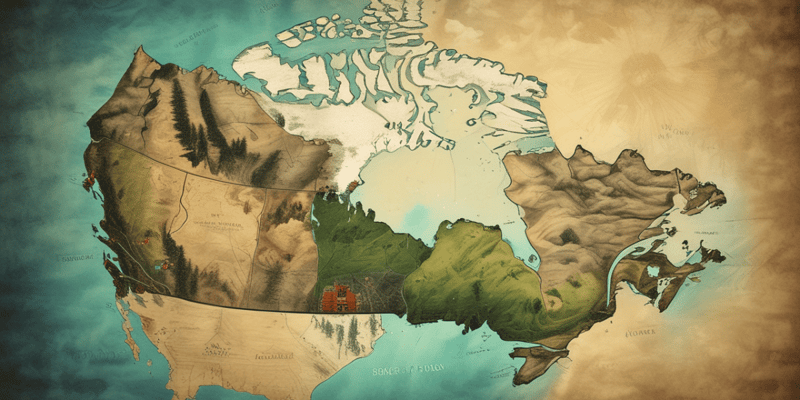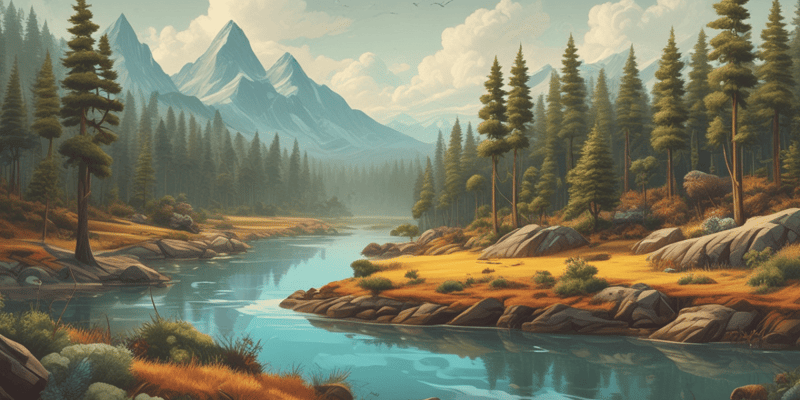Questions and Answers
What are the three tectonic plates that the Middle East lies on?
Eurasian, African, and Arabian plates.
What are the causes of earthquakes?
Sudden movement of plates, explosions, and eruptions.
What is the Rim of Fire and where is it located?
The Rim of Fire is an area where 95% of volcanoes are located. It is located in the Pacific Ocean basin and surrounds the coasts of Asia and the Americas.
What are the factors that led to the Syrian war?
Signup and view all the answers
What were the consequences of the Syrian war?
Signup and view all the answers
What are the two types of glaciers?
Signup and view all the answers
What are the features that glaciers create through erosion?
Signup and view all the answers
What is an ice age?
Signup and view all the answers
Study Notes
Geography Finals Notes
-
An earthquake is the vibration of the earth's surface caused by sudden movement of plates, explosions, and eruptions.
-
Areas most prone to earthquakes are the Rim of Fire, where 95% of volcanoes are located.
-
Tectonic plates constantly move away towards or past each other, causing earthquakes when their stress is released.
-
The Middle East is located where Asia, Africa, and Europe meet, and is often in turmoil due to war and conflict.
-
The Middle East serves as the connective tissue of the continents of Europe, Africa, and Asia, and includes countries such as Iran, Iraq, Israel, and Saudi Arabia.
-
The Middle East lies on three tectonic plates: Eurasian, African, and Arabian, causing major to minor earthquakes and the formation of seas, gulfs, and mountains.
-
The Syrian war started due to complaints about high unemployment, corruption, and a lack of political freedom under President Bashar al-Assad.
-
International interference prolonged the conflict, escalated violence, worsened the humanitarian situation, fueled radicalization and terrorism, and complicated diplomatic efforts to resolve the conflict peacefully.
-
The Syrian war resulted in a high number of deaths and casualties, displacement and refugee crisis, destruction of infrastructure, and humanitarian and health crisis.
-
The Middle East is an important world region due to its harsh climate, vulnerability to natural disasters, strategic location, significant oil and gas reserves, and complex geopolitical dynamics.
-
Fossil fuels, such as oil and gas, are abundant in the Middle East due to tectonic activity over millions of years.
-
Glaciers are large, perennial accumulations of crystalline ice, snow, rock, sediment, and often liquid water that originate on land and move down slope under the influence of their own weight and gravity.Glaciers: Formation, Types, Erosion, and Impact on Landscapes
-
Glaciers are large masses of ice that form in upland and polar regions where it snows most of the time.
-
Glaciers can be classified into valley glaciers and continental ice sheets, which cover about 10% of the Earth's land area.
-
Valley glaciers flow in valleys previously occupied by streams and can merge with other valley glaciers. They are highly effective as erosional agents.
-
Continental ice sheets spread out and cover large areas, developing due to low levels of solar radiation reaching Earth's polar regions.
-
Ice is thickest near its center and flows outward in all directions from there. When ice flows over ocean water, ice shelves are formed, which can break off to form icebergs.
-
Glaciers form where average annual temperatures are near freezing point, a large amount of snow falls in winter, and temperature builds throughout the year and is not high enough to melt previous winter's snow.
-
Glaciers form the largest reservoir of fresh water on the planet and are found in about 47 countries.
-
Glaciers are retreating rapidly in many parts of the world, including Alaska, Montana, South America, Greenland, the Arctic, Europe, Asia, Africa, and Antarctica.
-
An ice age is a long interval of time when global temperatures are relatively cold and large areas on the Earth are covered by continental ice sheets and alpine glaciers.
-
Glaciers erode landscapes through plucking and abrasion, creating features such as striations, glacial valleys, hanging valleys, corries, arêtes, pyramidal peaks, and fjords.
-
Glaciers move much slower than rivers because they are made of frozen water. Both glaciers and rivers are freshwater and flow downhill.
-
Glacial ice is interlocking crystals of H20 that form once the ice and snow thickness reaches 50m. Flow of a glacier is not often smooth and continuous, and the end of the glacier is the snout.
Studying That Suits You
Use AI to generate personalized quizzes and flashcards to suit your learning preferences.
Description
Are you ready for your geography finals? Test your knowledge on earthquakes, the Middle East, and glaciers with this comprehensive quiz. Brush up on your understanding of tectonic plates, the Syrian war, and the impact of glaciers on landscapes. With questions ranging from the basics to advanced concepts, this quiz will challenge and expand your geographical knowledge. Don't miss out on the chance to ace your finals with this helpful study tool.




